CES 2006 Part VI - DVDO, Vidikron, Monster Cable, HP, Sanyo, NHT
By Chris Boylan
Widescreen Just Got Wider, and the Monster's in the Network
Continuing where we left off in Part 5, we're still in the LVCC South Hall where
DVDO announced that their new iScan VP30 High Resolution Video Scaling Engine ($1999) is now shipping. The VP30 supports output resolutions of up to 1920X1080 progressive (1080p). This makes it an ideal video scaler/processor to use with the next generation of 1080p HD projectors and flat panel displays.
The VP30 also supports switching of up to 12 video devices (9 with audio, including 4 HDMI inputs) so you can handle all the switching and scaling in your equipment rack, and just run a single wire to your display.
A processor such as the VP30 is useful not only for improving the resolution and picture quality of legacy SD sources, like DVD, NTSC broadcast television and (harrumph) video tape, but it is also ideally suited to match any source device - SD or HD - to the native resolution of your display. Want to watch 1080i HDTV from your set top box on your plasma display that has a resolution of 1366X768? The VP30's got you covered. How about sending DVD movies to your computer monitor at 1024X768? It can do that too. Rather than letting your display switch and sort out the various input resolutions of all your sources - 720p, 1080i, 480p, 480i - and then try to adapt these to your panel or display's ideal resolution (which many TVs just aren't very good at), let the VP30 do it for you.
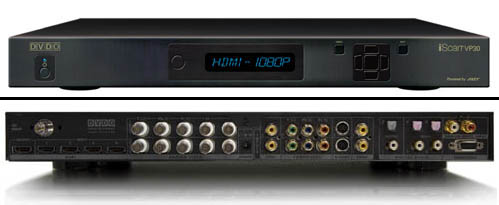
The VP30 includes inputs for up to 12 devices (including 4 HMDI A/V inputs).
Let's Get Wide, Let's Get Wi-ide!
If 16:9 just isn't wide enough for you, then you might want to look into projectors that support the CineWide feature, such as
Vidikron's 3-chip DLP projector, the Model 90 ($20,000 for projector plus $12,000 for anamorphic lens). The Model 90 features 720p native resolution and the ability to display aspect ratios wider than 16:9. The Vidikron's Autoscope feature detects the aspect ratio of incoming program material, then anamorphically squeezes the signal to fit the full resolution of the DMD chips, generating a 1280X720 image. The anamorphic lens then expands the image back out to its original aspect ratio and projects it onto a screen of the appropriate shape. For the demo, they used a Stewart Filmscreen Cinecurve model ($17,900 in 120 inch wide version) that adjusted automatically (based on program material) to an aspect ratio of up to 2.35:1 (Cinemascope). The Cinecurve screens also, as you might guess, include a slight curvature that draws you into the picture with a subtle sense of envelopment.
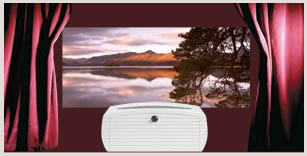
Vidikron's projectors that include Cinewide with Autoscope can project films with aspect ratios up to 2.35:1 without letterboxing.
The benefits of handling these super-wide aspect ratios anamorphically are a.) - you're using every last pixel of the DLP DMD to project the image, rather than wasting the top and bottom of the screen with black letterbox bars and b.) you get no light bleed in the masked out areas, the light is only projected onto the active area of the screen, maximizing perceived contrast. On ultra-wide program material (think "Ben Hur"), the effect is compelling, making the home viewing experience much more cinematic.
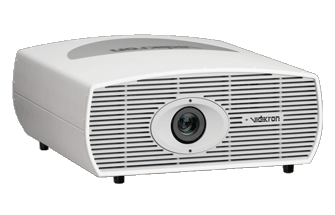
Vidikron's Model 90 projector.
A Monster in the Home Theater, and in the Bedroom, and in the Den, and...
Down the hall from Vidikron,
Monster Cable was showing a series of products in 5 separate demo rooms, the most interesting being the "Monster Control" demo and the "Monster Networking" demo. Monster Control was, of course, all about the new universal remotes from Monster. Designed in conjunction with Logitech's Harmony division and based on that company's excellent model 890 remote, the Monster remotes maintain the same ease of use and intuitive Web-based programming but add a few new goodies of their own like lighting controls and a web-based hook up wizard that doubles as a Monster Cable infomercial (need to hook your DVD up to your TV, try Monster component video cables!).
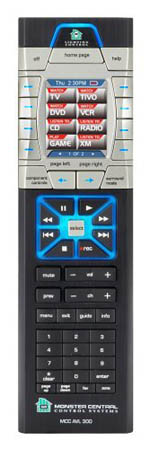
Monster's AVL-300 remote reduces a complicated home theater operation into a single button press.
The
AVL300 ($499, available winter, 2006) includes RF (Radio Frequency) and IR (Infrared) control, rechargeable battery and charging station. The
AV100 ($299.95, also available winter, 2006) which is similar to the AVL300 but without RF support or lighting controls. If the Monster remotes do turn out to be as easy to program and use as the Harmony remotes, then they'll have a couple of real winners on their hands.
The Monster home networking demo was a bit harder to describe. Monster's Control Net system is still under development but it was close enough to ready to give us a taste of what it can do. Monster's Control Net is based on the z-wave home networking control standard but it takes home networking to a level I've never seen before, integrating systems as disparate as home theater, lighting, climate control, home telephones, IP cameras, cell phones, security systems into a coherent whole.
The centerpiece of the Control Net system is the Nucleus neu-2000 ($3000, availability TBD), which is the wizard-based brain of the system. A talking head video of a woman (with a sexy Russian accent) asks you questions about your devices, how you use them, and where they're located, including DVD players, home theater receivers, lighting controllers, plasma TVs, telephones, blue-tooth enabled cell phones, webcams, etc. The wizard then automatically configures the home network controller to integrate and operate all of these devices around designated activities, like "watching a movie."
Beyond the sophistication of even advanced universal remote controls like the Harmony (and upcoming Monster remote), activities in the Monster Control Net are event-driven and location-driven. The presenter inserted a DVD into a Control Net-enabled DVD player, and this event triggered the system to automatically dim the lights in the room, turn on the receiver and plasma television, and set them to the appropriate inputs. When he turned off the receiver, this then triggered the system to shut down the other related devices and restore the room lighting to where it was before viewing the DVD.
But then the demo started getting really trippy. Walking into another "room" with a blue-tooth enabled cell phone and hitting "play" on the cell phone (which button on a phone corresponds to play I have no idea) caused a DVD player and TV in that room to power up and begin playing. The system's sensors detected that the bluetooth signal was strongest in that specific room and automatically routed the control codes to the devices in that room.
And since some cell phones can also connect to the internet (as an extension of your "home network"), they can also be enabled to monitor home security systems. In the event of a break-in, you can actually monitor an IP-based webcam in your home, see the intruder, then call your Control Net-enabled home phone and route your voice to the home theater system where you can politely inform the thief (at 120 decibels in surround sound) that the police are en route and you'd appreciate it if he would gently put down that plasma TV.
There were a few bugs here and there in the system but this is to be expected in such a comprehensive system. Expected availability is 3rd Quarter, 2006. This was easily one of the most impressive demos at CES in 2006. When home networking meant your toaster being able to talk to your refrigerator, I didn't get it. But now I'm starting to see the possibilities, and I can't wait to see what this looks like in production.
After the South Hall, a quick trip back to the Central Hall was in order, to check out
HP (Hewlett-Packard) and
Sanyo. HP is making a big push for the home theater/home entertainment market this year, with 9 new HDTV models and a new Media Center PC. The coolest new HDTV they introduced this year is a 37 inch LCD model, the SLC3760N (pricing TBA, shipping: early Spring, 2006). This model includes wired and wireless media hub functionality so it can stream audio, video and photos directly from any PC within your home network to the HDTV. In addition to support of all of the major video codecs (including Divx), the TV includes support for Microsoft WMV-HD via its built-in DRM (Digital Rights Management). You can also browse online photos with Snapfish, HP's online photo service, listen to music on-demand with Real Networks' Rhapsody music service, or download movies on-demand from
Cinemanow.
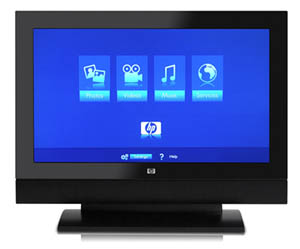
HP's SLC3760N 37 inch LCD TV includes a built-in digital media receiver which streams media files from your PC.
Among the other new HDTV models announced was a 52-inch DLP rear projection unit the ID5280N (pricing and availability TBD). This RPTV uses LED lamps instead of incandescent bulbs for illumination. Because it uses red, green and blue LED lamps, it bypasses the need for a color wheel, which is seen by some as the main weakness of single-chip DLP projection models. The ID5280N features 1080p resolution from a 720 DLP DMD chip, thanks to HP's "Wobulation" technology.
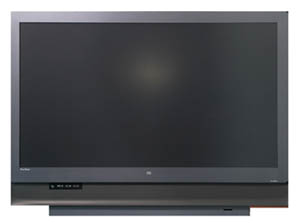
HP's latest 52 inch DLP projector uses LED lighting and needs no color wheel.
As for Sanyo, our readers will probably be most interested in their new PLV-Z4 3-chip LCD projector, featuring a 720P high definition native resolution and a whopping 7000:1 rated contrast ratio due to an improved iris. Best of all, the price: $2995 retail (but available for around $2000 "street price"). I've recently set one of these up at a friend's place and I must say the picture from the Z4 is the best yet from Sanyo and rivals or betters many of the more expensive single-chip DLP projectors I have seen and it sets the bar high for sub-$3K projectors.
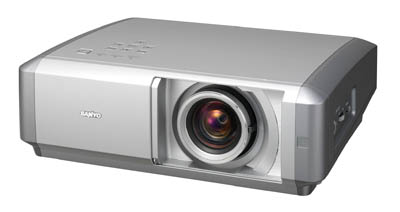
Sanyo's PLV-Z4 - huge screen high definition front projection TV for peanuts.
But Sanyo's bigger news was the impending March, 2006 release of their new Xacti HD1 digital media camera. Smaller than most camcorders - in fact, smaller than some digital still cameras - the HD1 can take 5.1 Megapixel still photos, but more interestingly, it can record video in widescreen high definition 720p resolution. And instead of a bulky tape, the HD1 records on tiny SD memory cards. Using efficient mpeg4 encoding, the unit can store up to 41 minutes of high definition video on a 2 GB SD (Secure Digital) card. And you get all this for $799. It would make an excellent match for the Z4 projector - 720p in, 720p out. Of course, you'll have to down-convert the video material if you want to burn it to DVD to send out to friends and family, but Blu-Ray and HD-DVD are right around the corner...
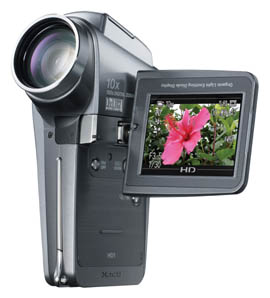
Sanyo's upcoming high def media recorder the xacti HD1 captures the action in 720p HD and stores it on tiny SD memory cards.
And right around the corner from the Convention Center was the Hilton hotel, where
NHT was showing off new speakers in their "Classic" line as well as the first electronics components to bear the NHT brand - the Controller ($2750, Shipping February, 2006) a 7.1 channel preamp/processor with HDMI and component video switching, and the Power5 ($2000, shipping February, 2006) a 5-channel high efficiency Class D amplifier.
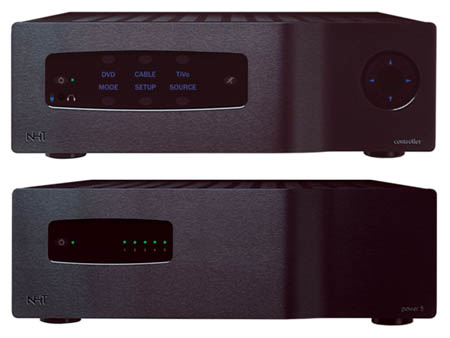
NHT's new Controller preamp/processor and Power5 5-channel amplifier.
Of course, NHT's new electronics can work with any speakers, however, if you use them with NHT speakers, the processor's built-in DSP engine automatically sets equalization, phase, low and high pass filters for the specific NHT speaker and subwoofer combination you are using.
NHT changed hands last year from Rockford Corporation to Vinci Labs of Colorado, although fortunately most of the personnel survived unscathed. It's nice to see that they're acknowledging the success of their "classic" SuperZero (one of my all-time favorite mini-monitors) and other speakers in the original Super line by putting out a new line with similar design, even better performance and a higher degree of fit and finish.
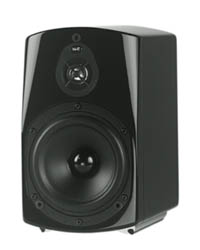
NHT's new "Absolute Zero" (MSRP: $200 each) - the audiophile classic mini-monitor makes a comeback. Welcome back, little guy!
That's it for Part 6. But read on to check out the Alexis Park high-end audio exhibits, including
McIntosh, Genesis, Von Schweikert, Joseph Audio, Von Gaylord Audio, Conrad-Johnson and more.
Just tuning in? Why not start at the beginning of our
CES 2006 Home Theater Report.









